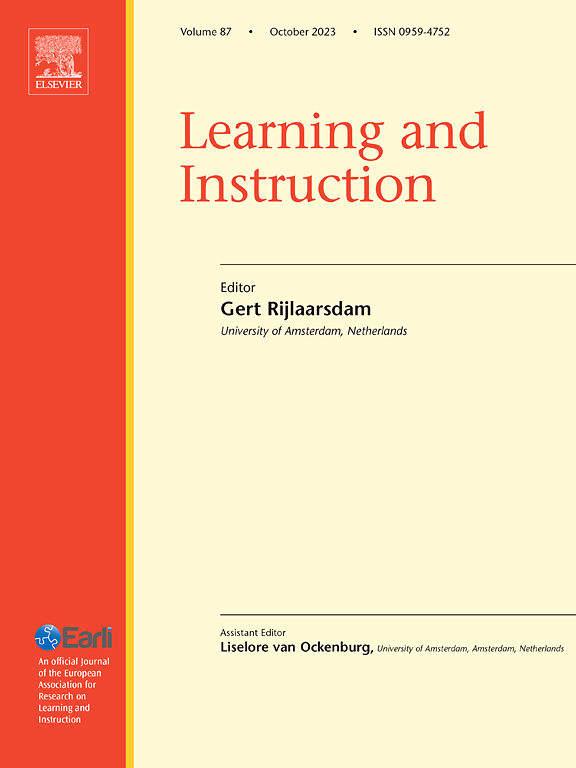合作学习中的情绪动态与调节
IF 4.9
1区 教育学
Q1 EDUCATION & EDUCATIONAL RESEARCH
引用次数: 0
摘要
研究表明,在协作学习过程中,学生对各种刺激事件的情绪反应是多样且波动的,但关于刺激事件、学生情绪反应和实施情绪调节策略之间关系的实证证据仍然很少。目的探讨群体成员在社会交往中如何协同构建情绪调节机制。具体而言,研究了学生在各种刺激事件中的情绪反应及其相关的情绪调节策略。样本:95名中学生在31个小组中完成了一项合作科学任务。方法对小组合作过程进行录像,观察刺激事件、学生相关情绪反应的效价以及小组成员言语互动中情绪调节策略的出现。学生的皮肤电活动被记录下来,以捕捉他们的情绪活动。采用时间网络、马尔可夫模型和序列分析方法探讨刺激事件、情绪反应和情绪调节策略之间的动态关系。结果小组情绪动态主要围绕三个实体:通过移情和情境调整调节任务相关刺激和外部刺激引起的消极情绪;通过相互支持管理社会刺激引起的情绪反应;通过幽默和相互积极反应增强小组的积极情绪。结论本研究有助于理解合作学习中的情绪和情绪调节,对教育实践具有一定的指导意义。通过采用多模态多渠道数据和新颖的学习分析方法,本研究有助于研究学习中情绪的方法的进步。本文章由计算机程序翻译,如有差异,请以英文原文为准。
Emotional dynamics and regulation in collaborative learning
Background
Research has evidenced that students exhibit diverse and fluctuating emotional responses to various stimulus events during collaborative learning, but the empirical evidence on the connections between stimulus events, students’ emotional reactions, and implemented emotion regulation strategies in a collaborative learning context is still scarce.
Aims
This study aims to explore how group members collaboratively construct emotion regulation in social interaction. Specifically, it investigates students’ emotional reactions in various stimulus events and the related emotion regulation strategies.
Sample
Ninety-five secondary school students performed a collaborative science task in 31 small groups.
Methods
The groups' collaboration was videotaped to observe stimulus events, the valence of the students' related emotional reactions, and the emergence of emotion regulation strategies in group members' verbal interactions. Students’ electrodermal activity was recorded to capture their emotional activation. Temporal networks, Markov models, and sequence analysis were used to explore the dynamics between stimulus events, emotional reactions, and emotion regulation strategies.
Results
The results showed that the groups’ emotional dynamics centered around three entities: regulating negative emotions caused by task-related and external stimuli by showing empathy and situation modification, supporting each other to manage emotional responses provoked by social stimuli, and enhancing positive emotions in the group using humor and reciprocal positive reactions.
Conclusions
This study contributes to the understanding of emotions and emotion regulation in collaborative learning, with implications for educational practice. By employing multimodal multichannel data along with novel learning analytics methods, the study contributes to the advancement of methods used to investigate emotions in learning.
求助全文
通过发布文献求助,成功后即可免费获取论文全文。
去求助
来源期刊

Learning and Instruction
Multiple-
CiteScore
11.30
自引率
4.80%
发文量
109
期刊介绍:
As an international, multi-disciplinary, peer-refereed journal, Learning and Instruction provides a platform for the publication of the most advanced scientific research in the areas of learning, development, instruction and teaching. The journal welcomes original empirical investigations. The papers may represent a variety of theoretical perspectives and different methodological approaches. They may refer to any age level, from infants to adults and to a diversity of learning and instructional settings, from laboratory experiments to field studies. The major criteria in the review and the selection process concern the significance of the contribution to the area of learning and instruction, and the rigor of the study.
 求助内容:
求助内容: 应助结果提醒方式:
应助结果提醒方式:


